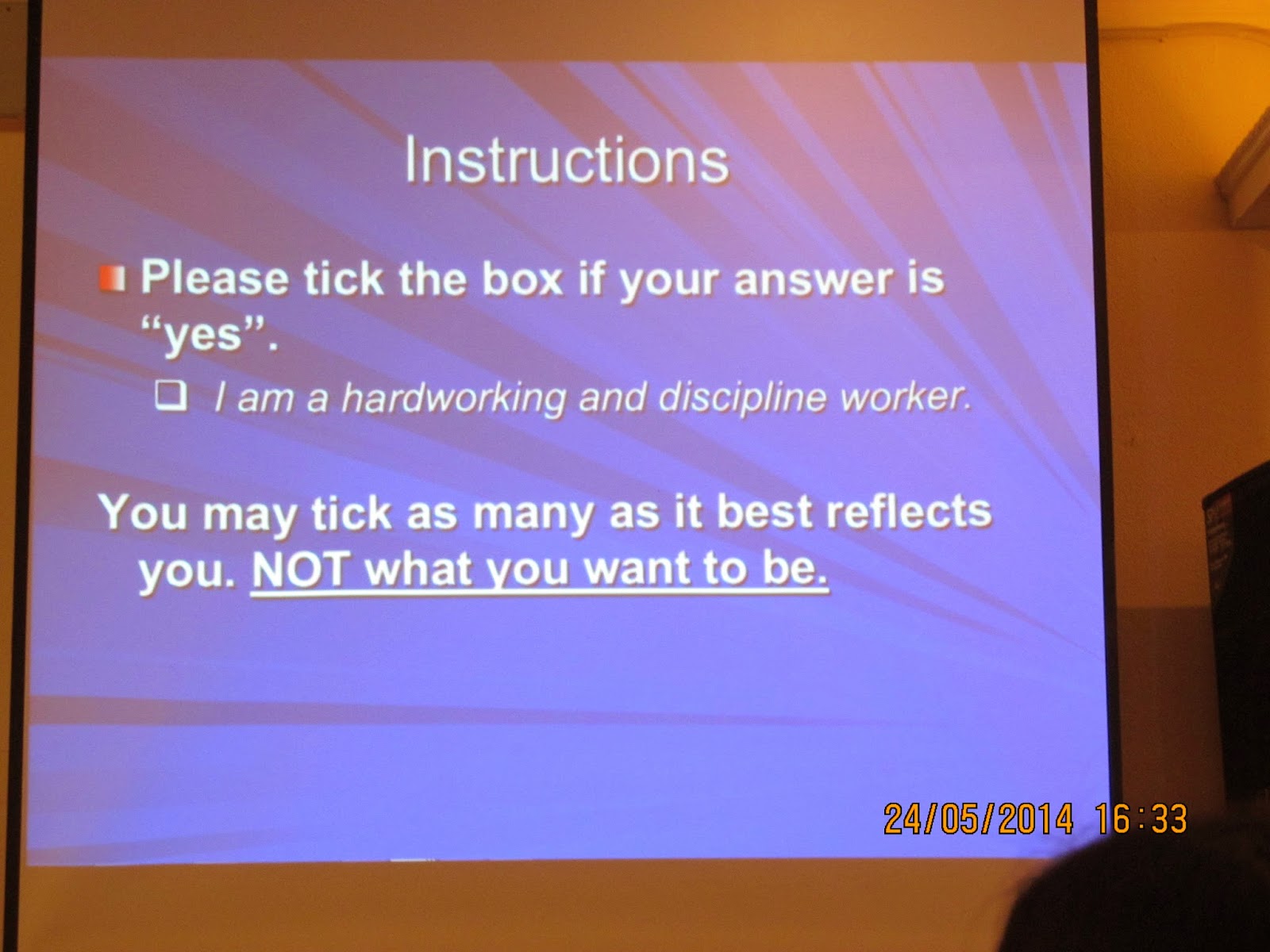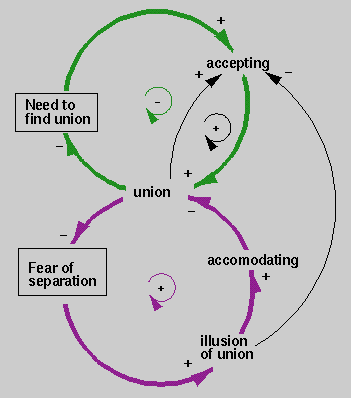.
.
.
.
.
.
.
.
.
.
.
.
Dynamics of Type 1: Reformer
World View: The world is an imperfect place. I work toward improvement.Basic Desire: to be right
Basic Fear: of being condemned
.
Healthy loop controlled by Basic Desire:
Need to
be right -> seek truth -> do the right thing -> Need to be right
In the healthy state, the
need to be right induces Type Ones to seek truth and do the right thing. When
Ones are doing the right thing, the need is satisfied and a balance is
reached.. In the average state, when Ones' are not working hard to seek the truth and do the right thing, the need to be right increases, which helps Ones to again work hard to seek the truth. Thus the balancing loop can help Ones to recover. . |
|
| Unhealthy loop controlled by Basic Fear: Fear of being condemned -> correct others -> do the right thing -> Fear of being condemned In the unhealthy state, the basic fear of being condemned can cause Type Ones to correct and condemn others first as a defense, which is often not the right thing to do, which further increases Ones' basic fear. The cycle continues to build up. . |
Insight
We can see from the diagram that a way to help break the control of the basic fear is to weaken the unhealthy loop. Ones can refrain from correcting others and start examining self for truth, which will help Ones to do the right thing, and reduce the fear of being condemned.
.
Diagram notations
.
.
.
Dynamics of Type 2: Helper
World View: People depend on my help. I am needed.
Basic Desire: to be loved
Basic Fear: of being unloved
Basic Desire: to be loved
Basic Fear: of being unloved
.
Healthy loop controlled by Basic
Desire:
Need to be
loved -> help others -> loved ->
Need to be loved
In the healthy state, the
need to be loved induces Type Twos to help others which causes them to be loved.
When Twos feel loved, the need is satisfied and a balance is reached..
In the average state, when Twos' are not helping others and are not loved, the need to be loved increases, which helps Twos to again reach out and help others. Thus the balancing loop can help Twos to recover.
.
Unhealthy loop controlled by Basic Fear:
Fear of
being unloved -> resent and
manipulate others -> loved -> Fear of being unloved
In the unhealthy state, the
basic fear of being unloved can cause Type Twos to feel resentful and try to
manipulate others into loving them. This can cause people to love them even
less, which further increases Twos' basic fear. The cycle continues to build
up. .
Insight:
We can see
from the diagram that a way to help break the control of the basic fear is to
weaken the unhealthy loop. Twos can refrain from manipulating others but start
to genuinely help others. This will cause Twos to be loved, and thus reduce the
fear of being unloved.
.
Diagram notations
.
.
Dynamics of Type 3: Motivator
World View: The world values a champion. Avoid failure at all costs.
Basic Desire: to be admired
Basic Fear: of being rejected
.
Basic Desire: to be admired
Basic Fear: of being rejected
.
Healthy loop controlled by Basic
Desire:
Need to be
admired -> self-improvement -> admired ->
Need to be admired
In the healthy state, the
need to be admired induces Type Threes to work hard to improve themselves and
succeed, which often cause others around them to admire them. When Threes feel
admired, the need is satisfied and a balance is reached..
In the average state, when Threes' are not working hard to improve themselves, others admire them less, which increases Threes' need to be admired. Thus this helps Threes to again work hard to improve themselves. Thus the balancing loop can help Threes to recover.
.
Unhealthy loop controlled by Basic Fear:
Fear of
being rejected -> compete -> admired ->
Fear of being rejected
In the unhealthy state, the
basic fear of being rejected can cause Type Threes to be competitive and
hostile towards others as a defense, which makes them even less admirable, and
further increases Threes' basic fear. The cycle continues to build up. .
Insight:
We can see
from the diagram that a way to help break the control of the basic fear is to
weaken the unhealthy loop. Threes can refrain from being competitive but focus
on self-improvement instead. This will lead to genuine admiration from others
and lessen the fear of rejection.
.
.
.
Dynamics of Type 4: Romantic
World View: Something's missing. Others have it. I'm different from
them because I don't.
Basic Desire: to understand self
Basic Fear: of being defective
Basic Desire: to understand self
Basic Fear: of being defective
.
Healthy loop controlled by Basic
Desire:
Need for
self-understanding -> examine self
-> understand themselves -> Need for self-understanding
In the healthy state, the
need for self-understanding induces Type Fours to allow their emotions to
surface and examine these emotions in order to understand themselves. When
Fours achieve self-understanding, their need is satisfied and a balance is
reached..
In the average state, when Fours' do not examine closely their emotions, they start to not understand themselves. This increases the need for self-understanding, which helps Fours to again examine themselves. Thus the balancing loop can help Fours to recover.
.
Unhealthy loop controlled by Basic Fear:
Fear of
being defective -> indulge in
fantasy -> understand themselves -> Fear of being defective
In the unhealthy state, the
basic fear of being defective can cause Type Fours to ignore their true selves,
allow their emotions to overwhelm them, and indulge in wild fantasy about
themselves. This means they will understand themselves even less, and further
increases Fours' basic fear. The cycle continues to build up. .
Insight:
We can see
from the diagram that a way to help break the control of the basic fear is to
weaken the unhealthy loop. Fours can refrain from indulging in fantasy and
start examining themselves. This will help Fours to understand themselves, and
reduce the fear of being defective.
.
Diagram notations
.
.
.
Dynamics of Type 5: Thinker
World View: The world is invasive and confusing. I need privacy to
think.
Basic Desire: to understand the world
Basic Fear: of being overwhelmed by the world
.
Basic Desire: to understand the world
Basic Fear: of being overwhelmed by the world
.
Healthy loop controlled by Basic
Desire:
Need to
understand the world -> observe -> analyze ->
understand the world -> Need to
understand the world
In the healthy state, the
need to understand the world induces Type Fives to observe and analyze the
world, which help them to better understand the world. When Fives reach a good
understanding of the world around them, their need is satisfied and a balance
is reached..
In the average state, when Fives' do less of observing and analyzing the world, they start to not understand the world. This increases their need to understand the world, which helps Fives to return to more observation and analysis. Thus the balancing loop can help Fives to recover.
.
Unhealthy loop controlled by Basic Fear:
Fear of
being overwhelmed by the world ->
detach from the world ->
understand the world -> Fear of
being overwhelmed by the world
In the unhealthy state, the
basic fear of being overwhelmed by the world can cause Type Fives to become
detached from the people around them and the world around them as a defense.
This unfortunately causes them to understand the world even less, which further
increases Fives' basic fear. The cycle continues to build up. .
Insight:
We can see
from the diagram that a way to help break the control of the basic fear is to
weaken the unhealthy loop. Fives can stop their detachment from the world, and
start to observe and analyze the real world more. This will increase their
understanding of the world, and reduce their fear of being overwhelmed by the
world
.
Diagram notations
.
.
Dynamics of Type 6: Skeptic
World View: The world is a threatening place. I need to look to
authority, but I question it.
Basic Desire: to be secure
Basic Fear: of being abandoned
.
Basic Desire: to be secure
Basic Fear: of being abandoned
.
Healthy loop controlled by Basic
Desire:
Need to be
secure -> loyal -> security ->
Need to be secure
In the healthy state, the
need to be secure induces Type Sixes to be loyal to others, especially the
authority. This increases their security among others, which satisfies their
need and a balance is reached..
In the average state, when Sixes' are not not being so loyal to others, they start to feel insecure among others. This increases the need to be secure, which helps Sixes to again seek out authority and become loyal to it, or become more loyal to others around them. Thus the balancing loop can help Sixes to recover.
.
Unhealthy loop controlled by Basic Fear:
Fear of
being abandoned -> distrust others
-> security -> Fear of being abandoned
In the unhealthy state, the
basic fear of being abandoned can cause Type Sixes to become suspicious of
others and start to distrust others. This reduces their sense of security,
which further increases Sixes' basic fear. The cycle continues to build up. .
Insight:
We can see
from the diagram that a way to help break the control of the basic fear is to
weaken the unhealthy loop. Sixes can refrain from distrusting others, and begin
to be more loyal to others. This will make them feel more secure, thus reduce
their fear of being abandoned.
.
Diagram notations
.
.
.
Dynamics of Type 7: Enthusiast
World View: The world is full
of opportunity and options. I look forward to the future.
Basic Desire: to be happy
Basic Fear: of being deprived
.
Basic Desire: to be happy
Basic Fear: of being deprived
.
Healthy loop controlled by Basic
Desire:
Need to be
happy -> explore and appreciate
world -> happy -> Need to be happy
In the healthy state, the
need to be happy induces Type Sevens to explore the world and genuinely
appreciate what they find. They derive great happiness as a result, thus their
need is satisfied and a balance is reached.
.
In the average state, when
Sevens' are not exploring and appreciating the world, they become restless and
unhappy. The the need to be happy increases, which helps Sevens to again reach
out to the world and find things to appreciate. Thus the balancing loop can
help Sevens to recover.
.
Unhealthy loop controlled by Basic Fear:
Fear of
being being deprived -> numbly
seek sensations -> happy -> Fear of being being deprived
In the unhealthy state, the
basic fear of being being deprived can cause Type Sevens to numbly seek new and
different sensations and adventures without truly appreciating the experience.
This means they will derive little happiness from all the highs, which further
increases Sevens' feeling of emptiness and basic fear of being deprived. The
cycle continues to build up.
.
Insight:
We can see
from the diagram that a way to help break the control of the basic fear is to
weaken the unhealthy loop. Sevens can refrain from jumping into the next
project, and appreciate more what they experience. This will cause them to be
more happy, and thus reduce their fear of being being deprived.
Diagram notations
.
.
.
Diagram notations
Dynamics of Type 8: Leader
World View: The world is an
unjust place. I am strong and I defend the innocent.
Basic Desire: to be self-reliant
Basic Fear: of submitting to others
Basic Desire: to be self-reliant
Basic Fear: of submitting to others
.
Healthy loop controlled by Basic
Desire:
Need to be
self-reliant -> strength -> independent ->
Need to be self-reliant
In the healthy state, the
need to be self-reliant induces Type Eights to become stronger and capable of
defending others. When Eights are independent, their need is satisfied and a
balance is reached.
.
In the average state, when
Eights' are not building their strength as much, they will become more
dependent on others for certain needs. This increases the need to be
self-reliant, which helps Eights to again work hard to become strong. Thus the
balancing loop can help Eights to recover.
.
Unhealthy loop controlled by Basic Fear:
Fear of
submitting to others ->
controlling -> independent -> Fear of submitting to others
In the unhealthy state, the
basic fear of submitting to others can cause Type Eights to lash out and try to
control others as a defense. This unfortunately make them ironically more
dependent on others, which further increases Eights' basic fear. The cycle
continues to build up.
.
Insight:
We can see
from the diagram that a way to help break the control of the basic fear is to
weaken the unhealthy loop. Eights can refrain from controlling others but start
to strengthen themselves instead. This will naturally make them more
independent and thus reduce the fear of submitting to others.
.
.
.
Basic Desire: to find union and peace
Basic Fear: of separation
.
Dynamics of Type 9: Peacemaker
World View: My efforts won't matter to the world. It's best to keep the peace.Basic Desire: to find union and peace
Basic Fear: of separation
.
Healthy loop controlled by Basic
Desire:
Need to
find union -> accept others -> do the right thing -> Need to find union
In the healthy state, the
need to find union induces Type Nines to genuinely open up to others and accept
them as they are. Others often find their acceptance welcoming and build up a
strong bond or union. This way, Nines' need are satisfied and a balance is
reached.
.
In the average state, when
Nines' are less accepting of others or the world, which means the union begins
to weaken. This causes the the need to find union to increase, which helps
Nines to again become more accepting of others. Thus the balancing loop can
help Nines to recover.
.
Unhealthy loop controlled by Basic Fear:
Fear of
separation -> illusions of union -> accommodating -> union ->
Fear of separation
In the unhealthy state, the
basic fear of separation can cause Type Nines to delude themselves with
illusions of union, which they sustain by ignoring reality and blindly
accommodating others or the world. Unfortunately, this means they won't achieve
true union, which further increases Nines' basic fear. The cycle continues to
build up.
.
Insight:
We can see
from the diagram that a way to help break the control of the basic fear is to weaken
the unhealthy loop. Nines can stop indulging in illusions of union, and start
to really accept others. This will build real union, and reduce the fear of
separation.















































No comments:
Post a Comment